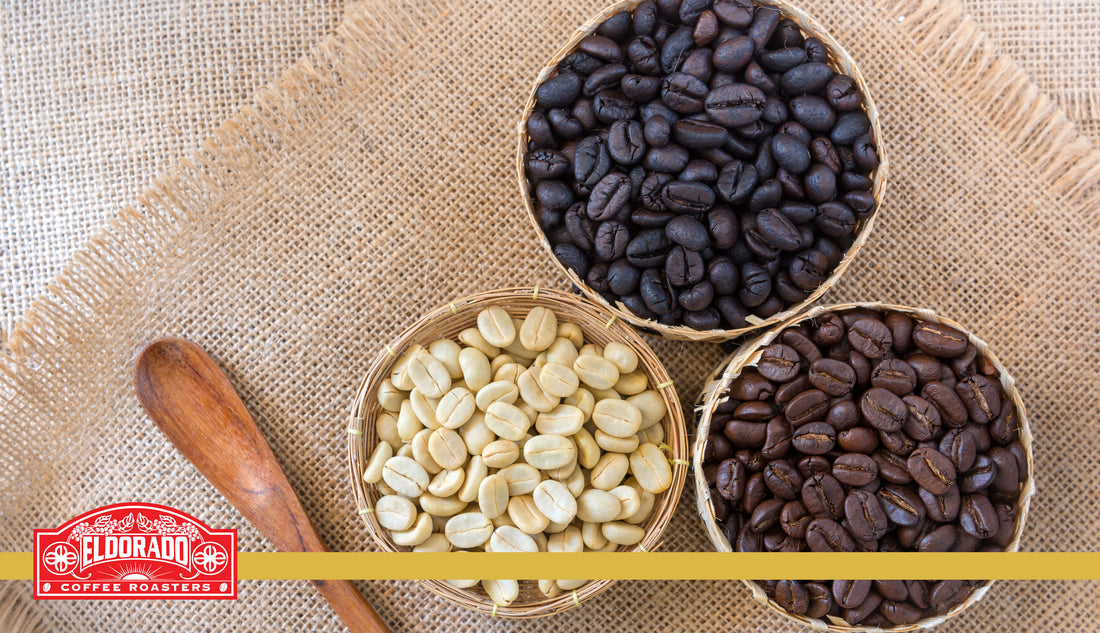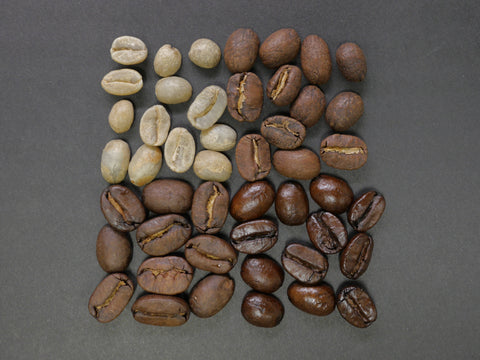
Light vs Dark Roast: Find Your Perfect Roast
Share
The “roast” is the foundation of a coffee’s flavor and fragrance. Most Americans don’t know the differences between light vs medium vs dark roasts, or what this means for the aroma and taste of their cup of java.
To enhance your coffee drinking experience—and to truly figure out what kind of coffee best fits your palate—it’s a good idea to have an understanding of the different types of coffee roasts, like a dark roast vs medium roast or a light roast coffee vs dark roast.
That’s why we’re giving you everything you need to know about coffee roasts—from the roasting process, to the particular tastes and textures of each roast—so you can experiment to find your favorite for yourself.
What is “roasting”?
Roasting refers to the process of heating coffee beans so they’re ready to be ground and brewed.
Coffee beans are actually green. After harvesting, the best coffee beans are shipped and stored while still green. This helps retain moisture, which maintains the quality and taste of the bean.
But, you can’t use green coffee beans to make coffee. They’re too soft and spongy (and they smell like grass).
Heating the beans (aka roasting) creates a chemical change that brings out the flavor and aroma that we typically associate with coffee beans. This roasting process removes some of the excess moisture from the beans, leaving behind a crunchy brown bean, ready for boiling and brewing.
How to roast
Coffee roasters bring the beans to a high temperature, until they’ve reached their ideal “crack.” The crack determines what the flavor of the roast will be. When the beans have reached the peak of their roasting point, the beans are quickly cooled to stop the roasting process.
What’s a crack?
A crack simply refers to the temperature threshold of the roast. The first crack is around 385 degrees Fahrenheit, when the coffee bean’s moisture has evaporated. You can actually listen for the first “crack” sound. At about 435 degrees Fahrenheit, the bean cracks a second time. If you wait too long after the second crack, the beans will burn and become inedible.
The importance of freshness
Once coffee is roasted, its shelf life starts. That’s why, at Eldorado, we roast all of our coffee right here in Queens, New York. This local roast ensures that you get the freshest possible coffee delivered to your door.
To keep your coffee fresh after roasting, we recommend storing beans in an opaque, airtight container, at room temperature. You want to subject the coffee beans to as little light, heat, and moisture as possible, to avoid compromising the taste. Store the beans somewhere dark, cool, and airtight, and your coffee will remain fresh for weeks!
Different roasts
So, now you know a little bit about the roasting process. What are the different types of coffee roasts? What’s the difference between light vs dark roast?
Light roast
Light roast coffee beans have the mildest flavor. They have a gently toasted taste, often with floral or fruity notes.
Light roast means that the beans are heated until the “first crack,” usually about 350 to 401 degrees Fahrenheit. This means it’s roasted for the least amount of time of all the roasts.
Because light roast is roasted for the least amount of time and at the lowest temperature, it usually has the highest amount of caffeine and acidity—since the caffeine and acidity haven’t had time to burn off. This creates a light brown bean, that’s not oily on the surface (it wasn’t roasted long enough for the oils to break through).
It’s often referred to as: light roast, light city roast, half city roast, cinnamon roast, or New England roast.
Medium roast
Medium roasts are the most popular type of roast in America, which is why they’re often referred to as “American” roasts. This is the roast you think of when you think of a classic cup of coffee at a diner or café in an American town. If you hear the phrases city roast, American roast, breakfast roast, or even “regular” roast, they’re referring to this medium coffee level.
Medium roasts are heated for a slightly longer time than light roasts, usually at 425 degrees. The roasting is stopped just before the beginning of the second crack. The beans still aren’t roasting long enough for oil to emerge from the bean, but the longer roasting process reduces the acidity, compared to the light roast.
This sort of roast has a balanced flavor, with strong aroma. Typically, the source of the bean matters most with a medium roast, because the medium roasting process tends to enhance the bean’s undertones. Where the coffee is grown in the world will generally define what these flavor notes will taste like.
Medium dark roast
A medium dark roast works well for someone who likes a more bittersweet taste of coffee, with rich, full flavor notes. This roast sometimes brings out a spicier or tangier flavor, especially depending on the origin of the beans.
It’s usually heated to 437 to 445 degrees Fahrenheit, roasted to the beginning or middle of the second crack. “Full city” is a medium dark roast usually heated to the beginning of the second crack, while “after dinner roast” is heated a little longer (so it’s sometimes considered a darker roast).
If you’re a fan of both American coffee and espresso, a medium dark roast is a great in-between option!
What’s the difference between dark roast vs medium roast? Keep reading!
Dark roast
A dark roast, like a Colombian roast, creates a dark brown or black bean with a shiny, oily surface. These beans are roasted until the end of the second crack, usually between 445 and 480 degrees. This high heat pulls out more of the bean’s oils, which creates a heavier and richer feel in the mouth.
There are a lot of names for a dark roast. It’s the most popular form of roast in Europe, so you’ll often see it referred to as “European roast,” “Italian roast,” “French roast,” or “Viennese roast.” It’s also referred to as “high roast,” “continental roast,” or “New Orleans roast.”
When you drink espresso (or espresso drinks, like cappuccino), you’re drinking a dark roast. It’s this dark roast that creates that well-known bitter, smoky, or burnt taste, but it’s also smoother and less acidic than lighter roasts.
Some people believe dark roast coffee health benefits are greater than that of other roasts, but we haven’t seen any scientific proof either way. If you’re interested, you can learn more about dark roast coffee health benefits here.
Extra dark roast
Extra dark roasts aren’t popular, but you may run into them once in awhile. (In fact, the first extra dark roast came to America by Illy in 2016.)
This process goes at about 475 or 480 degrees, creating a very black and oily bean. It extends well beyond the second crack, so it has a more burnt or charred flavor. It’s an acquired taste that some people enjoy, sometimes for use as a coffee concentrate in recipes.

Which roast has the most caffeine?
There’s a widespread misconception that darker roasts have more caffeine. But in the light roast vs dark roast caffeine debate, light roast coffee beans actually come out on top!
Although they have a stronger flavor, dark roasts actually do not have more caffeine. That’s because the roasting process actually burns off the caffeine. That means that lighter roasts have a slightly higher concentration of caffeine than dark roasts!
In actuality, though, light roast vs dark roast caffeine is comparable--almost equal. The differences are minimal. Just know that, in general, the caffeine varies slightly based on roast, and the beans lose caffeine the darker the roast.
Keep in mind that the caffeine content also varies based on the type of bean, where it was harvested, and even how it’s brewed. See the caffeine content of different types of drinks here.
Other variables to consider
You can definitely taste a difference between light roast coffee vs dark roast, but the roast alone won’t determine the taste of your cup. The roast is the foundation, but you also need to consider:
- Grind type
- Brewing method
- Age of the coffee
- Freshness of roast
- Country of origin
- Growing and harvesting methods
- Processing methods
Even the cleanliness of the roasting machine can change the flavor of delicate coffee beans! So, you want to be aware of all of the different variables while you’re trying to find your favorite roast, and ideal cup.
Your perfect roast
You won’t know which roasts you like best until you’ve tried them all a few times over!
Try out different Eldorado roasts with our perfect roast bean slider! You simply slide the red dot to the roast you’d like, and you’ll see a ton of delicious and authentic options available through Eldorado. Take your pick, and start experimenting!
Not sure where to start? Our D-Shoppe Blend is a fan-favorite medium roast you’ll fall in love with!

